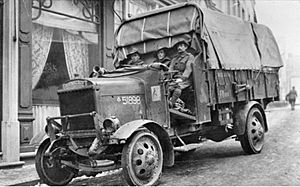Thornycroft J Type facts for kids
Quick facts for kids Thornycroft J Type |
|
|---|---|

Thornycroft J Type of the 1st AIF
|
|
| Type | 3-ton lorry |
| Place of origin | United Kingdom |
| Service history | |
| Used by | British Empire |
| Wars | First World War |
| Production history | |
| Designer | Thornycroft |
| Manufacturer | Thornycroft |
| Produced | 1911–1926 |
| Specifications | |
| Mass | 4.52 t (4.45 long tons) |
| Length | 22 ft 2 in (6.76 m) 13 ft 8 in (4.17 m) wheelbase |
| Width | 7 ft 3 in (2.21 m) |
| Height | 10 ft 5 in (3.18 m) |
|
|
|
| Engine | Thornycroft I4 6,256 cc petrol 45 bhp (34 kW) |
| Payload capacity | 3 long tons (3.0 t) |
| Drive | 4x2 |
| Transmission | 4F1R |
| Suspension | Semi-elliptical multi-leaf springs |
| Maximum speed | 12 mph (19 km/h) |
| References | A complete directory of military vehicles |
The Thornycroft J Type was a strong British truck. The Thornycroft company built it. This truck was used a lot by the British military and other forces. It served during the First World War.
Contents
Building the Thornycroft J Type
The J Type was a big truck. It could carry 3 tons of weight. It had a special engine called a Thornycroft M4. This engine had four cylinders. It was a petrol engine. It made 45 horsepower. The engine powered the back wheels. It used a four-speed gearbox.
How the J Type Helped in War
The Thornycroft company designed the J Type in 1911. They made it for a special plan. This plan was from the War Office. It helped civilian companies buy trucks. The government gave them money for suitable trucks. But, the military could take the trucks if they needed them.
At first, the War Office bought a few types of trucks. These were the H, J, and K Types from Thornycroft. The first trucks arrived in 1912 and 1913. But by August 1914, they chose the J Type. It became the main truck.
Over 5,000 J Type trucks went to the British military. This was during the war. Some also went to other forces. The British Army used these trucks until 1930. After the war, Thornycroft made a new truck. It was called the X Type. It was based on the J Type.
J Type as an Anti-Aircraft Gun
The British Army needed to stop enemy planes. So, they made mobile anti-aircraft guns. They took a QF 13-pounder gun. They put it on the back of a J Type truck. This made a special anti-aircraft (AA) gun.
Thornycroft built 183 of these special trucks. The guns were later updated. They were called the 13-pounder 9 cwt. These trucks were very popular with the soldiers. They were known for being very reliable. They worked well on the Western Front. They stayed in service until the end of the war. The Canadian Army used them until 1930. The only problem was they were not good off-road.
Where to See a J Type Today
There is a J Type lorry that still works. Its number is 14201. It is part of the Hampshire Cultural Trust collection. It joined the collection around 1990.
See also
- List of combat vehicles of World War I


